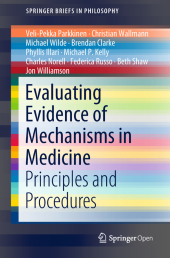 Neuerscheinungen 2018Stand: 2020-02-01 |
Schnellsuche
ISBN/Stichwort/Autor
|
Herderstraße 10
10625 Berlin
Tel.: 030 315 714 16
Fax 030 315 714 14
info@buchspektrum.de |

Veli-Pekka Parkkinen, Christian Wallmann, Michael Wilde
(Beteiligte)
Evaluating Evidence of Mechanisms in Medicine
Principles and Procedures
1st ed. 2018. 2018. xviii, 125 S. 14 SW-Abb., 1 Farbtabellen. 235 mm
Verlag/Jahr: SPRINGER, BERLIN; SPRINGER INTERNATIONAL PUBLISHING 2018
ISBN: 3-319-94609-9 (3319946099)
Neue ISBN: 978-3-319-94609-2 (9783319946092)
Preis und Lieferzeit: Bitte klicken
This book is open access under a CC BY license.
This book is the first to develop explicit methods for evaluating evidence of mechanisms in the field of medicine. It explains why it can be important to make this evidence explicit, and describes how to take such evidence into account in the evidence appraisal process. In addition, it develops procedures for seeking evidence of mechanisms, for evaluating evidence of mechanisms, and for combining this evaluation with evidence of association in order to yield an overall assessment of effectiveness.
Evidence-based medicine seeks to achieve improved health outcomes by making evidence explicit and by developing explicit methods for evaluating it. To date, evidence-based medicine has largely focused on evidence of association produced by clinical studies. As such, it has tended to overlook evidence of pathophysiological mechanisms and evidence of the mechanisms of action of interventions.
The book offers a useful guide for all those whose work involves evaluating evidence in the health sciences, including those who need to determine the effectiveness of health interventions and those who need to ascertain the effects of environmental exposures.
1 Introduction 1.1 What is a mechanism? 1.2 Where does evidence of a mechanism come from? 1.3 Why consider evidence of mechanisms? 1.3.1 Evaluating efficacy 1.3.2 Evaluating external validity 1.3.3 Other questions 1.3.4 Importance of considering evidence of mechanisms 2 How to consider evidence of mechanisms: a summary 2.1 Questions to address 2.2 Quality level of evidence and status of claim 2.3 Identifying evidence of mechanisms in the literature 2.4 Evaluating evidence of mechanisms 2.5 Using evidence of mechanisms to evaluate causal claims 2.6 Overall approach 3 Identifying evidence of mechanisms in the literature 3.1 Hypothesize a mechanism 3.2 Search the literature 3.3 Identify the evidence most relevant to the mechanism hypothesis 3.4 Presenting the evidence of mechanisms 4 Evaluating evidence of mechanisms 4.1 Considerations for evaluating evidence of mechanism 4.2 Presenting quality of evidence of mechanisms 5 Using evidence of mechanisms to evaluate efficacy and external validity 5.1 Efficacy 5.2 External validity 6 Glossary 7 References 8 Acknowledgements 9 Appendix A. A critical appraisal tool for evidence of mechanisms 10 Appendix B. GRADE tables with mechanism assessment 11 Appendix C: Databases for evidence of mechanisms 12 Appendix D: Assessing exposures 12.1 Example: carcinogenicity of benzo[a]pyrene 12.2 Comparison to IARC 12.3 Molecular epidemiology 12.4 Comparison to SYRINA
The authors of this book are members of EBM+ (ebmplus.org), a network of researchers investigating the role of evidence of mechanisms in the health sciences. During the writing of this book, Parkkinen, Wallmann, Wilde and Williamson were based at the Centre for Reasoning, University of Kent; Clarke, Illari and Norell at the Department of Science and Technology Studies, UCL; Kelly at the Department of Public Health and Primary Care, University of Cambridge; Russo at the Department of Philosophy, University of Amsterdam; and Shaw at the National Institute of Health and Care Excellence, UK. This research way supported by the UK Arts and Humanities Research Council and the Leverhulme Trust.


